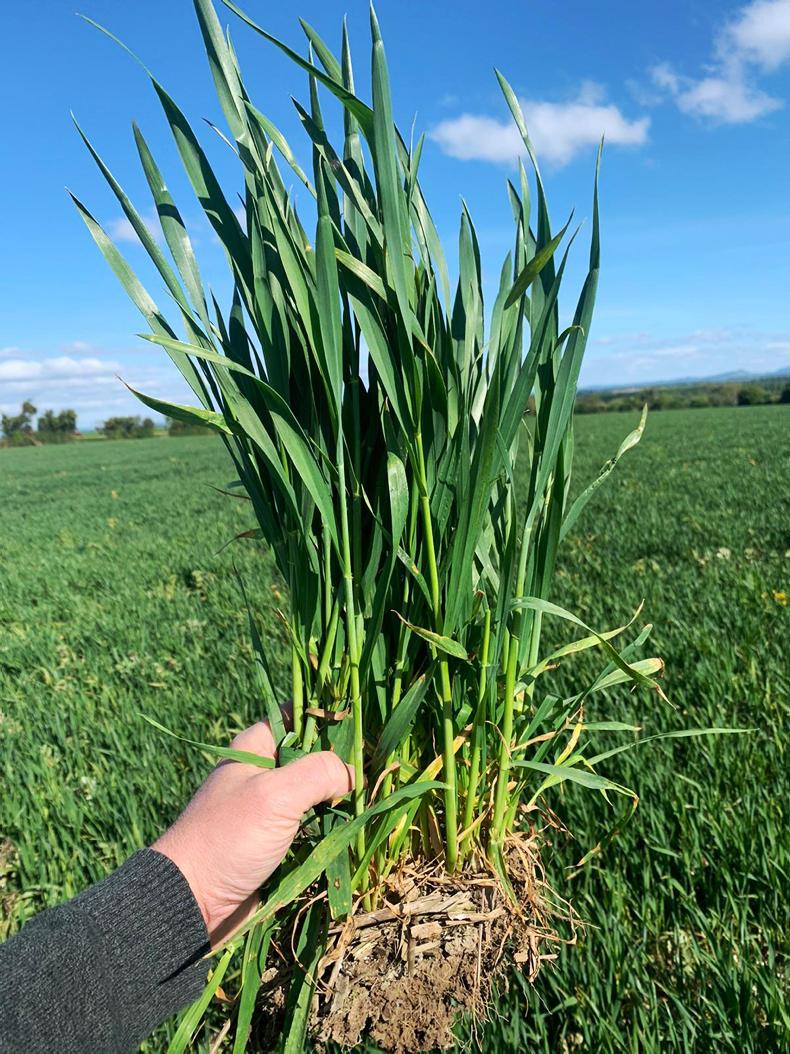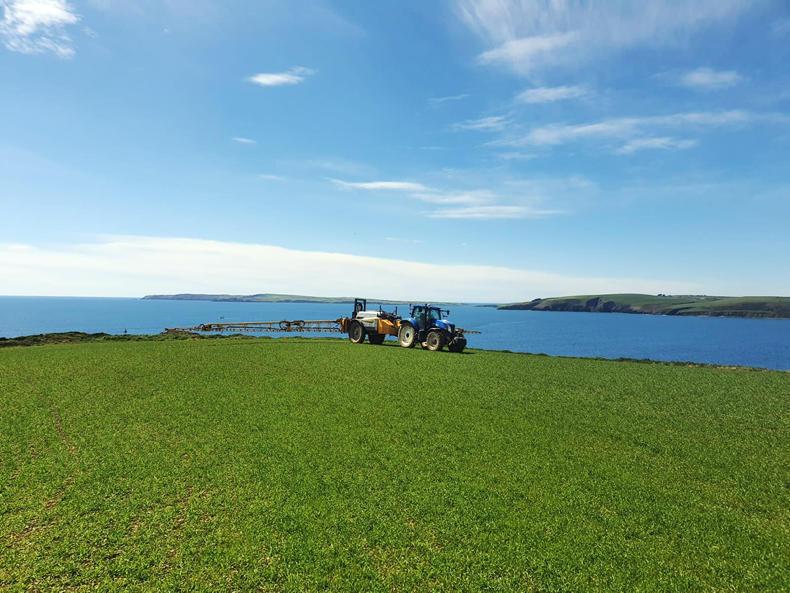Tuam,
Co Galway
Spring crops are coming along very well in Tuam this season, helped by good sowing conditions and establishment. However, the west hasn’t escaped the dry weather, having received just one or two showers of rain over the past month. Interestingly, conditions on Gerry’s farm are actually dryer now than they were this time two years ago, during the drought of 2018. Rain would be welcome.

Gerry's Husky winter oats crops are due a T1 spray this week.
Despite the dry conditions, Gerry is optimistic about the potential of his spring crops this year. His land is heavy and suits a dry year like this. His Mickle spring barley is in late tillering and received a herbicide application of Tower (1.5l/ha) two weeks ago. He was specifically targeting grassweeds with this spray. He also applied an aphicide, Sparviero, at 50ml/ha.
Lack of available manganese for growing crops is a regular feature on Gerry’s farm and this is amplified during dry weather. Last Saturday, he applied manganese sulphate (2.5l/ha) to address this.
Disease pressure appears to be low, but he intends on applying a T1 fungicide application next Saturday
Gerry applied 335kg/ha of 18:2.5:14 with trace elements into the seedbed when sowing.
He brought the crop up to 162kg N/ha when plants were at the 2-3 leaf stage. Disease pressure appears to be low, but he intends on applying a T1 fungicide application next Saturday.
Awns peeping
The awns are peeping in Gerry’s winter barley crops. This year, he is growing Cassia and Infinity winter barley. Gerry commented that his Infinity crop is not looking great, as it is thin and lacks vigour.
The panicles are emerging in his winter Husky oat crops
This isn’t the first time a crop of Infinity has failed to impress him on his farm. His Cassia crop is the opposite, full and rich in colour. He intends on applying a T2 at the end of the week. Three weeks ago, the crops received a T1 consisting of Bravo (1l/ha), Coyote (0.7l/ha) and Ceraide (1.25l/ha).
The panicles are emerging in his winter Husky oat crops. The crop received an application of Talius (0.2l/ha and Ceraide (1.25l/ha) three weeks ago.
Stabannon,
Co Louth
Conditions are very dry in Louth, explains Gareth. Just 20mm of rain fell on his farm since March 17, while other farms close by have recorded as little as 1mm. The 5cm of the soils are bone dry and roots have to go deep to find moisture.

Gareth’s winter wheat crops consists of four mixed varieties.
He is happy with his spring-sown Wizard beans, which now have around eight leaves. The crop was sown with spring oats in combination, but germination of the oat seed is patchy.
At the four-leaved stage, his spring oats are under pressure due to lack of moisture
The crop has received no herbicide, however. The crop was brought up to 91kg S/ha and 32kg K/ha. It received a combination of phosphate, magnesium sulfate, seaweed and boron sprays.
At the four-leaved stage, his spring oats are under pressure due to lack of moisture. They have so far received an application of phosphate and have been brought up to 125kg N/ha, 125kg K/ha and 17kg P/ha.
Gareth’s spring barley crops are doing much better, as they are sown on stronger ground. So far, it has received 137kg N/ha, 100kg K/ha, 22kg P/ha and 81kg S/ha. The crop received an early application of foliar nitrogen at the three-leaved stage, which helped drive it on. His spring cereals haven’t received a herbicide yet and won’t receive an aphicide this season, Gareth says. His three-way combi-crop of oats (20%), barley (30%) and peas (50%) is just emerging now.
His four-way winter wheat variety crops are at various stages of flag leaf emergence and have yet to receive a fungicide
Gareth had to replant 30ac of winter oilseed rape. He opted to plant spring oilseed rape (3kg/ha) along with clover (3kg/ha) and also added in oats (120kg/ha) for an amount of this to promote root diversity. He is aiming to drill winter wheat directly into the clover in the autumn.
His four-way winter wheat variety crops are at various stages of flag leaf emergence and have yet to receive a fungicide. Gareth applied phosphite (2.5l/ha), MagS (3l/ha), seaweed (1.5l/ha), Boron (0.75l/ha) and N16 (15l/ha) after a yellow rust outbreak, which appeared to halt the spread, he said.
Kinsale,
Co Cork
In contrast to the rest of the country, after the weather settled on 25 March, Martin had a perfect spring, with spells of good drying weather and intermittent periods of rain. Establishment has been excellent and all crops are now looking good.
His beet crops emerged with a good plant stand and will likely receive a T1 herbicide application by the end of the week, consisting of a Debut, Venzar and Betanal Maxx Pro mix.

Martin applying a herbicide on spring barley with his Chefer Century sprayer. In the background is thee Old Head of Kinsale.
His spring wheat is progressing through the growth stages and is now at GS29. Last week, the crop received Cameo Max (60g/ha), Binder (0.75l/ha), as well as the aphicide Sumi-Alpha (0.165ml/ha). Martin thinks the crop will be due its T1 in around a weeks’ time.
Crops also received an application of manganese trace elements
Most of his spring cereals have been sprayed with Cameo Max (60g/ha), Hurler (0.75l/ha), as well as Sumi-Alpha (0.165ml/ha), while the balance will be sprayed this week. The earliest crops are at GS29. His spring barley feed crops have been brought to 170kg N/ha, while his malting crops have been brought to 150kg N/ha. Crops also received an application of manganese trace elements (1l/ha). His spring oats are around GS29 and have been brought to 140kg/ha.
Spraying
Martin sprays with a Chafer Sentry 5,000l sprayer on 30m booms, equipped with GPS section control. He bought the sprayer three years ago under TAMS. After studying the sprayer at the Cereals show in the UK, he determined that this sprayer, which has baffles in the tank, would be best equipped to handle hilly ground.
Martin is very happy with the progress of his Belfry hybrid crops
The awns are emerging in his winter barley crops and are due to receive a T2 of Bravo (1l/ha) and Ceriax (1.5l/ha), as well as magnesium (1l/ha) this weekend. Last Saturday, the crops received Terpal (1.25l/ha) and around three weeks ago, the crop received a T1 of Commet (0.5l/ha) and Decoy (0.5l/ha).
Martin is very happy with the progress of his Belfry hybrid crops, which are thick and lush. His six-row pixel crops are not as thick, but are still looking well.
Tuam,
Co Galway
Spring crops are coming along very well in Tuam this season, helped by good sowing conditions and establishment. However, the west hasn’t escaped the dry weather, having received just one or two showers of rain over the past month. Interestingly, conditions on Gerry’s farm are actually dryer now than they were this time two years ago, during the drought of 2018. Rain would be welcome.

Gerry's Husky winter oats crops are due a T1 spray this week.
Despite the dry conditions, Gerry is optimistic about the potential of his spring crops this year. His land is heavy and suits a dry year like this. His Mickle spring barley is in late tillering and received a herbicide application of Tower (1.5l/ha) two weeks ago. He was specifically targeting grassweeds with this spray. He also applied an aphicide, Sparviero, at 50ml/ha.
Lack of available manganese for growing crops is a regular feature on Gerry’s farm and this is amplified during dry weather. Last Saturday, he applied manganese sulphate (2.5l/ha) to address this.
Disease pressure appears to be low, but he intends on applying a T1 fungicide application next Saturday
Gerry applied 335kg/ha of 18:2.5:14 with trace elements into the seedbed when sowing.
He brought the crop up to 162kg N/ha when plants were at the 2-3 leaf stage. Disease pressure appears to be low, but he intends on applying a T1 fungicide application next Saturday.
Awns peeping
The awns are peeping in Gerry’s winter barley crops. This year, he is growing Cassia and Infinity winter barley. Gerry commented that his Infinity crop is not looking great, as it is thin and lacks vigour.
The panicles are emerging in his winter Husky oat crops
This isn’t the first time a crop of Infinity has failed to impress him on his farm. His Cassia crop is the opposite, full and rich in colour. He intends on applying a T2 at the end of the week. Three weeks ago, the crops received a T1 consisting of Bravo (1l/ha), Coyote (0.7l/ha) and Ceraide (1.25l/ha).
The panicles are emerging in his winter Husky oat crops. The crop received an application of Talius (0.2l/ha and Ceraide (1.25l/ha) three weeks ago.
Stabannon,
Co Louth
Conditions are very dry in Louth, explains Gareth. Just 20mm of rain fell on his farm since March 17, while other farms close by have recorded as little as 1mm. The 5cm of the soils are bone dry and roots have to go deep to find moisture.

Gareth’s winter wheat crops consists of four mixed varieties.
He is happy with his spring-sown Wizard beans, which now have around eight leaves. The crop was sown with spring oats in combination, but germination of the oat seed is patchy.
At the four-leaved stage, his spring oats are under pressure due to lack of moisture
The crop has received no herbicide, however. The crop was brought up to 91kg S/ha and 32kg K/ha. It received a combination of phosphate, magnesium sulfate, seaweed and boron sprays.
At the four-leaved stage, his spring oats are under pressure due to lack of moisture. They have so far received an application of phosphate and have been brought up to 125kg N/ha, 125kg K/ha and 17kg P/ha.
Gareth’s spring barley crops are doing much better, as they are sown on stronger ground. So far, it has received 137kg N/ha, 100kg K/ha, 22kg P/ha and 81kg S/ha. The crop received an early application of foliar nitrogen at the three-leaved stage, which helped drive it on. His spring cereals haven’t received a herbicide yet and won’t receive an aphicide this season, Gareth says. His three-way combi-crop of oats (20%), barley (30%) and peas (50%) is just emerging now.
His four-way winter wheat variety crops are at various stages of flag leaf emergence and have yet to receive a fungicide
Gareth had to replant 30ac of winter oilseed rape. He opted to plant spring oilseed rape (3kg/ha) along with clover (3kg/ha) and also added in oats (120kg/ha) for an amount of this to promote root diversity. He is aiming to drill winter wheat directly into the clover in the autumn.
His four-way winter wheat variety crops are at various stages of flag leaf emergence and have yet to receive a fungicide. Gareth applied phosphite (2.5l/ha), MagS (3l/ha), seaweed (1.5l/ha), Boron (0.75l/ha) and N16 (15l/ha) after a yellow rust outbreak, which appeared to halt the spread, he said.
Kinsale,
Co Cork
In contrast to the rest of the country, after the weather settled on 25 March, Martin had a perfect spring, with spells of good drying weather and intermittent periods of rain. Establishment has been excellent and all crops are now looking good.
His beet crops emerged with a good plant stand and will likely receive a T1 herbicide application by the end of the week, consisting of a Debut, Venzar and Betanal Maxx Pro mix.

Martin applying a herbicide on spring barley with his Chefer Century sprayer. In the background is thee Old Head of Kinsale.
His spring wheat is progressing through the growth stages and is now at GS29. Last week, the crop received Cameo Max (60g/ha), Binder (0.75l/ha), as well as the aphicide Sumi-Alpha (0.165ml/ha). Martin thinks the crop will be due its T1 in around a weeks’ time.
Crops also received an application of manganese trace elements
Most of his spring cereals have been sprayed with Cameo Max (60g/ha), Hurler (0.75l/ha), as well as Sumi-Alpha (0.165ml/ha), while the balance will be sprayed this week. The earliest crops are at GS29. His spring barley feed crops have been brought to 170kg N/ha, while his malting crops have been brought to 150kg N/ha. Crops also received an application of manganese trace elements (1l/ha). His spring oats are around GS29 and have been brought to 140kg/ha.
Spraying
Martin sprays with a Chafer Sentry 5,000l sprayer on 30m booms, equipped with GPS section control. He bought the sprayer three years ago under TAMS. After studying the sprayer at the Cereals show in the UK, he determined that this sprayer, which has baffles in the tank, would be best equipped to handle hilly ground.
Martin is very happy with the progress of his Belfry hybrid crops
The awns are emerging in his winter barley crops and are due to receive a T2 of Bravo (1l/ha) and Ceriax (1.5l/ha), as well as magnesium (1l/ha) this weekend. Last Saturday, the crops received Terpal (1.25l/ha) and around three weeks ago, the crop received a T1 of Commet (0.5l/ha) and Decoy (0.5l/ha).
Martin is very happy with the progress of his Belfry hybrid crops, which are thick and lush. His six-row pixel crops are not as thick, but are still looking well.









 This is a subscriber-only article
This is a subscriber-only article









SHARING OPTIONS: